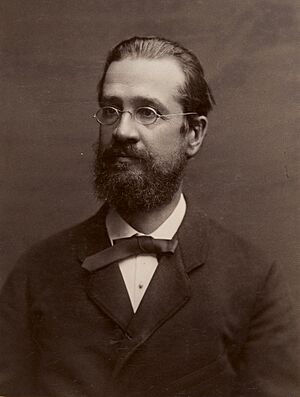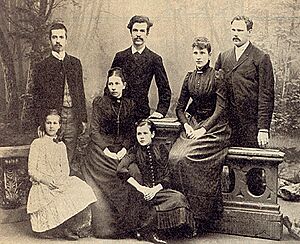Julius Krohn facts for kids
Quick facts for kids
Julius Krohn
|
|
|---|---|
 |
|
| Born | 19 April 1835 Viipuri, Finland
|
| Died | 28 August 1888 (aged 53) Bay of Vyborg
|
| Spouse(s) | Emilia "Emma" Sofia Nyberg Maria "Minna" Wilhelmina Lindroos |
| Children | Kaarle Krohn Ilmari Krohn Helmi Krohn Aune Krohn Aino Kallas |
| Parent(s) | Leopold Wilhelm Krohn Julie Dannenberg |
| Academic background | |
| Alma mater | University of Helsinki |
| Influences | Elias Lonnrot |
| Academic work | |
| School or tradition | Fennoman |
| Main interests | Finnish mythology, Kalevala Scholarship |
| Notable ideas | The Historic-Geographic Method |
| Influenced | Kaarle Krohn |
Julius Leopold Fredrik Krohn (born April 19, 1835 – died August 28, 1888) was an important Finnish researcher. He studied old Finnish poems and stories. He was also a poet, writer, and translator. Julius Krohn was born in Viipuri, Finland. His family had Baltic German roots, and he spoke German as his first language. He taught Finnish at the University of Helsinki. He became one of the most famous experts on Finnish folk poetry in the 1800s.
Contents
About Julius Krohn
Julius Krohn's mother was Julie Dannenberg. She came from a German family near Vyborg. Julie was very talented. She could speak eight languages. She also played the piano wonderfully. Part of her family also had roots in a place called Ingria.
His Work and Impact
Julius Krohn often used a pen name instead of his real name. He also worked with groups, like the Fennoman movement. He was a main leader in this group. He translated many works by Johan Ludvig Runeberg into Finnish. Researchers also believe he wrote the Finnish words for the Finnish national anthem.
As the Writer "Suonio"
His most famous pen name was Suonio. Under this name, he published poems. Some of his poetry books were Mansikoita ja mustikoita (1856–61). This means "Strawberries and blueberries." He also wrote Kuun tarinoita, which means "Tales of the moon." As Suonio, he worked as an editor for Suomen Kuvalehti magazine. He also translated many novels by Sir Walter Scott. One example is A Legend of Montrose.
His Scientific Research
Julius Krohn made a big contribution to Finnish literature. His doctoral paper in 1862 was called Suomenkielinen runollisuus ruotsinvallan aikana. This was about Finnish poetry during Swedish rule.
Krohn was also the first to create a scientific way to study folklore. This method is called the historic-geographic method. It helps researchers compare different versions of old stories. The goal is to find the "original" version of a folk tale. This method is linked to how people understood their own folk culture.
Julius Krohn died when he was 53 years old. He drowned in the Bay of Vyborg in a yachting accident. His son, Kaarle Krohn, continued his work. Kaarle published many of his father's scientific writings after his death. Their student, Antti Aarne, later developed this work even further.
His Children
Julius Krohn had several children who became famous. His son Kaarle Krohn continued his work in folklore. Another son, Ilmari, became a composer of church music.
His daughter, Aino, married Oskar Kallas from Estonia. She became a well-known writer. His daughter Helmi Krohn was also an author. She married Eemil Nestor Setälä. He later became the acting head of state of Finland in November 1917.


